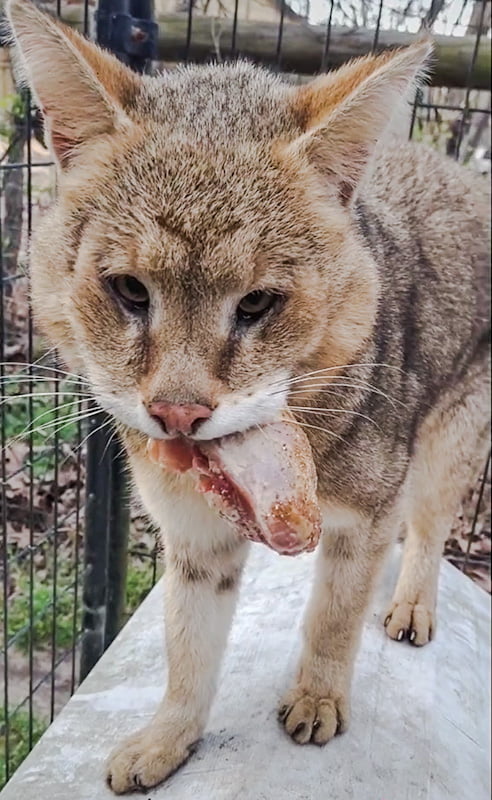OVERVIEW: Felis chaus is the scientific name for the jungle cat; a small wild cat species that has a passing similarity in appearance to the Abyssinian purebred cat. The coat is plain tawny grey and ticked. Its color varies slightly. It is found from Turkey to Cambodia – a very wide distribution. Its name is misleading as this wild cat species prefers swamps and reed beds – next to water. It is also called the Chaus, “reed cat”, “swamp cat” or “swamp lynx”. Due to their wide range, they are also found in dry grasslands. The jungle cat feeds mainly on small mammals such as mice and rats. They leap to catch birds. This is a highly adaptable feline suited to all seasons and all habitats. It shuns dense rainforest and arid desert, two extremes of habitat. It is described as a “flexible, all-purpose cat” by Dr. Desmond Morris, the well-known zoologist which makes it more accepting of human alterations to their habitat. The jungle cat is long-legged and as a consequence fast-moving. They been timed at 23 km/h (I’d expect near 30 km/h typically). The jungle cat climbs well but is a ground dweller
This article is over several pages with links at the base of each section to the next.

Here is a video of a captive jungle cat looking anxious and stressed in my view. It looks like a private zoo environment. I don’t like to see it but it does show the appearance and size very well. Sometimes these videos disappear over time. If it does not work, I apologise but I don’t control its existence on the internet.
This individual jungle cat looks big. He looks like he weighs around 20-25 pounds.
@avalocats Tiberius Jungle Cat #junglecat #jc #junglecathybrid #exoticcatsoftiktok #exoticcat #catsanctuary #swampcat #reedcat #catsoftiktok #catsvideo
Here is a screenshot from the above video:
Description
From a distance there appears to be no markings on the coat but on closer inspection the coat reveals a few faint bands on the legs and tail. The ears are quite sharply pointed with long black hairs at their tips. These create small ear tufts. The tale is on the short-side.
As mentioned, to the casual eye, the jungle cat looks a bit like the Abyssinian cat (but less refined) and of course the Chausie. The Abyssinian cat is said to originate in Egypt or somewhere in and around the Indian Ocean, probably, in fact, from the east coast of India. Felis chaus also occupies Egypt so there is a geographic connection and might be an ancestral connection – the Abyssinian originating from the jungle cat, why not? We don’t know.
The size of felis chaus is similar to that of the domestic cat weighing around 5 kg for females to around 10 kg for males (22 pounds). It is a little larger and lankier, however. A size comparison chart with other felids can been seen here: Wild Cat Species by Size.



Thanks.
They were also found as a pet in ancient China